Observing the night sky is a humbling and awe-inspiring experience, but many people wonder, “Can I see the Milky Way with my eyes?” The Milky Way, our home galaxy, is a massive collection of stars, gas, and dust spanning over 100,000 light-years in diameter. When we look up at the sky, we view a small portion of this magnificent structure.
Yes, you can see the Milky Way with your eyes. To witness it in all its glory, it’s essential to be in a dark sky area, away from the light pollution of cities and towns. Under ideal conditions, the Milky Way appears as a milky band of light arching across the sky, which is how it got its name. Seeing the Milky Way at night is a truly mesmerizing experience that connects you to the vastness of our universe.
In this article, you get
A solid overview of when and where to see the Milky Way
Tips on capturing photographs of the Milky Way with your camera
Example photos of the Milky Way galaxy
An understanding of the term “Milky Way Season”
A quick look at the effects of Light Pollution
Techniques for finding the Milky Way in the night sky
By the end of this article, you’ll have all the info you need to see the Milky Way with your eyes and much more!
Let’s dive right in.
Recommended For You
Can I see the Milky Way with My Eyes: Introduction
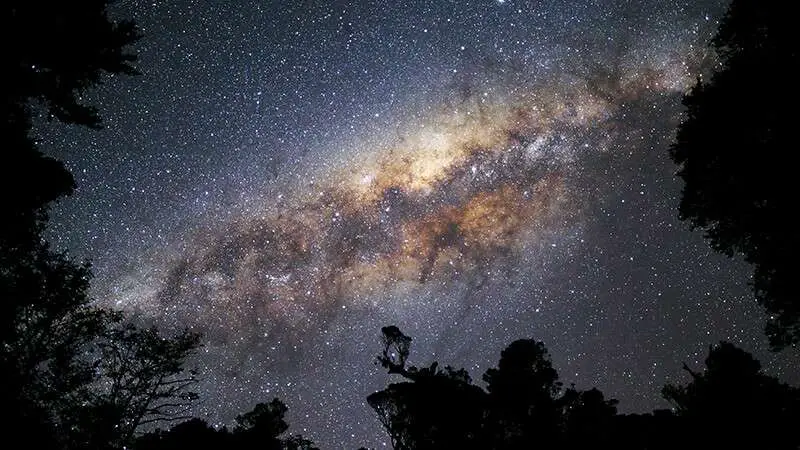
To fully appreciate the majestic sight of our home galaxy, it is crucial to understand when and where to look and be equipped with patience and determination. Ever wonder what lies at the center of the Milky Way?
Is the Milky Way visible to the eye? Yes, in this section, I’ll provide tips on when and where to view the Milky Way with your unaided eye.
The best time of year to see the Milky Way
The Milky Way is most visible during the summer. This time of year is best because the galactic center, the brightest part of our galaxy, is highest in the night sky during these months.
We amateur astronomers refer to this time of year as Milky Way Season. The season in which the galactic core is best visible in the night sky. The galactic core is the center of the Milky Way, where it is the brightest in the sky. Milky Way Season is roughly the period between when we change our clocks forward by an hour until when we change them back.
Here’s an example of the visibility of the Milky Way Galactic Center in California.

The best time of the night to see the Milky Way
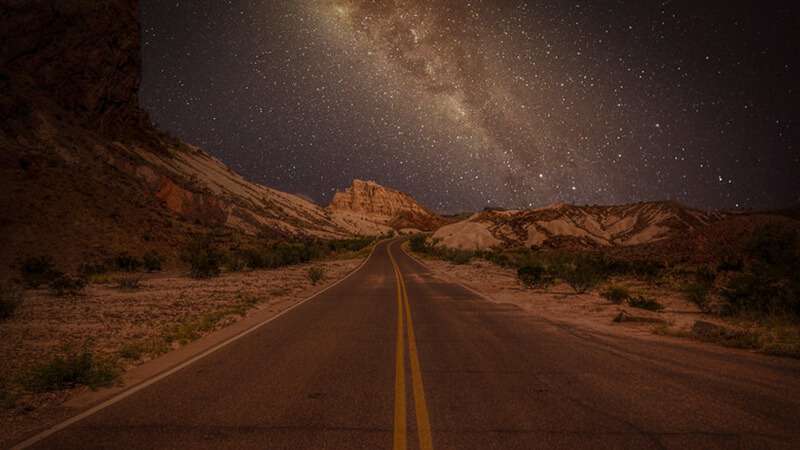
Plan your observation time around the New Moon when the sky is darkest to get the best view. Start looking for the Milky Way about an hour after sunset, when it becomes easier to see. As the night progresses, the galaxy’s visibility will improve until it reaches its peak around midnight.
Another option is to plan your stargazing session before moonrise or after moonset. This way, you’ll have the darkest hours of the night sky, making it easier to see the Milky Way.
FREE STARGAZING CHECKLIST
My 5-page Stargazing Checklist will enhance your astronomical observations.
Follow this free checklist to navigate the night sky with confidence, clarity, and a sense of preparedness for a rewarding stargazing experience.

The best locations in the US to observe the Milky Way
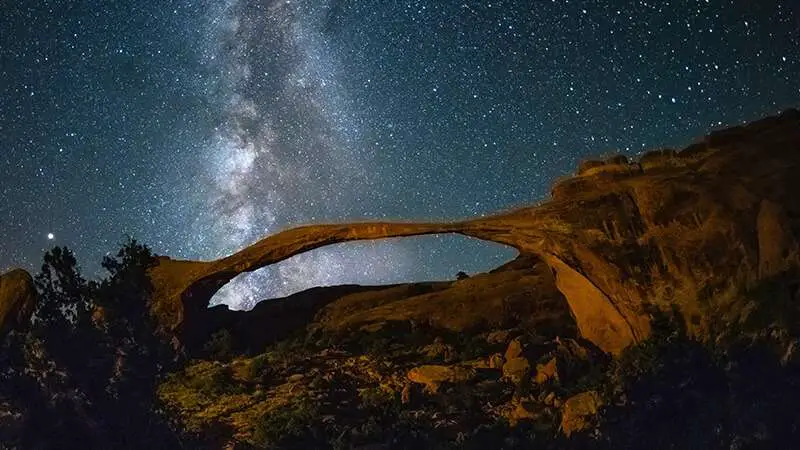
Finding a location with minimal light pollution is crucial for observing our galaxy. Some of the best spots in North America include places that are certified by the International Dark Sky Association as being an International Dark Sky Park.
Where can you see the milky way?
- Haleakala National Park, Hawaii
- Joshua Tree National Park, California
- Death Valley National Park, California
- Many places in Sedona, Arizona
- Natural Bridges National Monument, Utah
- Great Sand Dunes National Park and Preserve, Colorado
- Big Bend National Park, Texas
- Big Cypress National Preserve, Florida
Remember to check the weather, dress warmly, and be patient while waiting for the Milky Way to appear. You can enjoy a breathtaking view of our galaxy with the right conditions and knowledge!
Factors Affecting Your Ability to See the Milky Way
Light Pollution and Its Impact

Light pollution from cities and towns makes it difficult to see the Milky Way. To increase your chances of spotting it, find a dark sky location away from artificial light sources. Also, avoid any direct light sources such as flashlights or streetlights.
The Effects of the Moon Phase
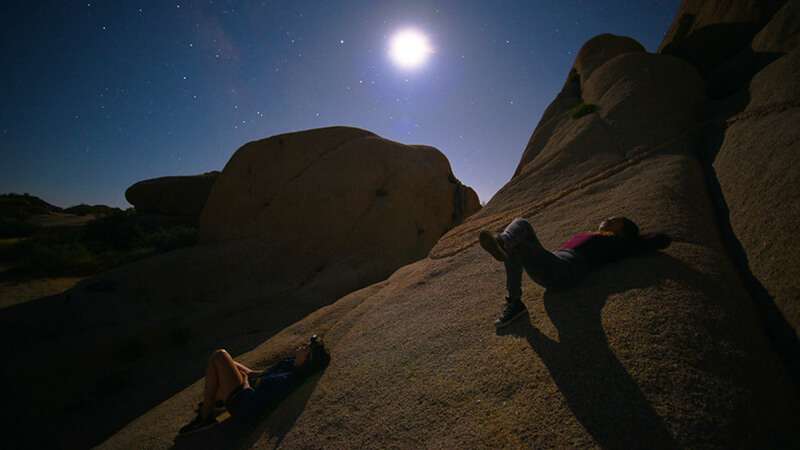
As the introduction mentions, the Moon’s phase can also impact your ability to see the Milky Way. Aim to observe during a new moon since the sky will be darker, leading to better visibility of stars and the galaxy. If you can’t avoid the lunar glow, plan your stargazing around the moonrise and moonset times.
Other Visibility Factors

Elevation and atmospheric conditions play a role in the visibility of the Milky Way. For example, higher elevations are generally better for stargazing as they offer clearer skies. Also, check the weather forecast for clear skies and low humidity, as clouds and moisture can hinder your view.
How to find the Milky Way in the Night Sky

To locate the Milky Way in the northern hemisphere, look Southeast or South, depending on the time of night. You should be able to see it arching across the night sky. If you can find the Big Dipper constellation or the North Star, turn around to face the southern sky. You’ll then be able to see the galactic core during the summer.
how to see the milky way
- Find a Dark Location: Choose a spot far away from light pollution, such as city lights. National parks or remote areas are excellent options.
- Check Moon Phases: Plan your stargazing on nights when the moon is not too bright or absent, as moonlight can wash out the Milky Way’s faint light.
- Use a Star Chart or Stargazing App: These tools help you locate the Milky Way and identify its position in the night sky.
- Arrive After Sunset: Wait until well after sunset to allow your eyes to adjust to the dark. This can take about 20-30 minutes.
- Use Red Light: Red light won’t affect your night vision, so use a red flashlight or cover your regular flashlight with red cellophane to read star charts or navigate without disrupting your sight.
- Look Southward: In the northern hemisphere, the Milky Way is usually most prominent in the southern part of the sky.
- Scan the Sky: Gaze upward, scanning the sky for a faint, cloudy band of light. The Milky Way’s appearance varies throughout the year, so consult your star chart or app for its current position.
- Patience: Sometimes, it may take a while for your eyes to fully adapt to the darkness and for the Milky Way to become visible.
Here’s an example of a Milky Way selfie I took. I put my camera on a tripod and set its timer to take photos every minute. I ran up the hill and got into this pose. The Milky Way core is visible behind me. I’ll give more night photography tips later in the article.
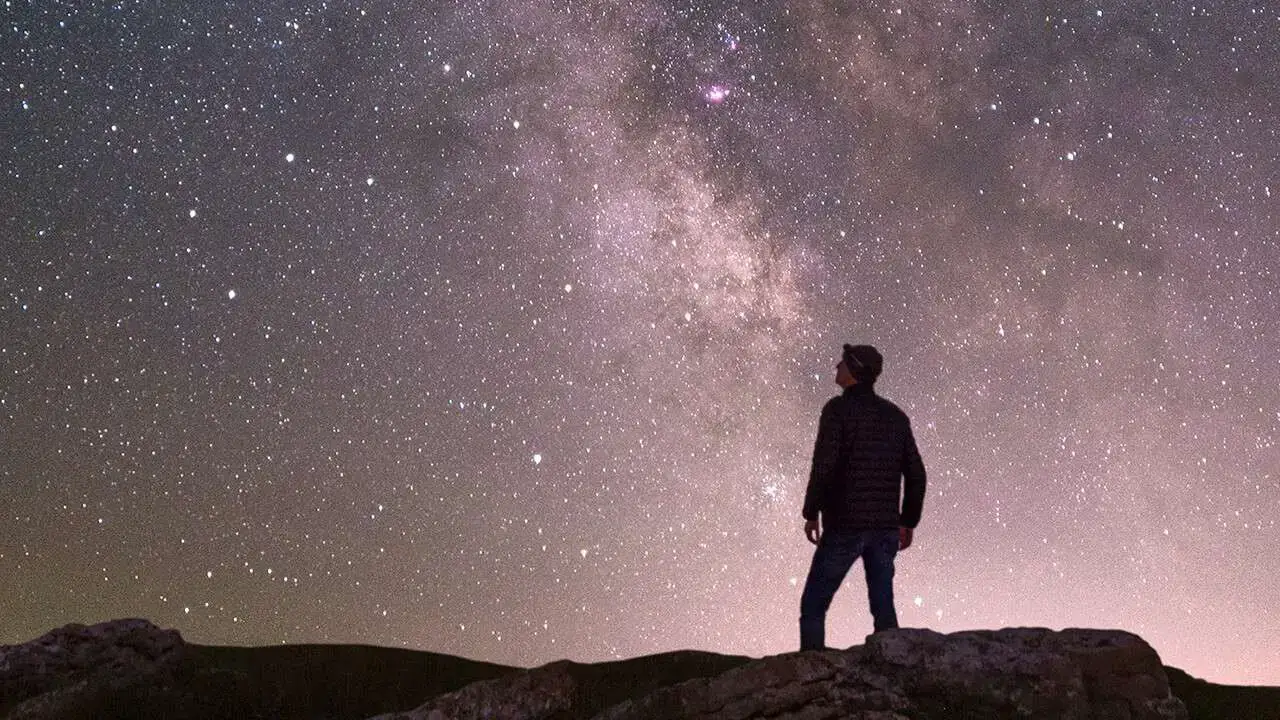
What to Expect When Viewing the Milky Way
Distinct Features
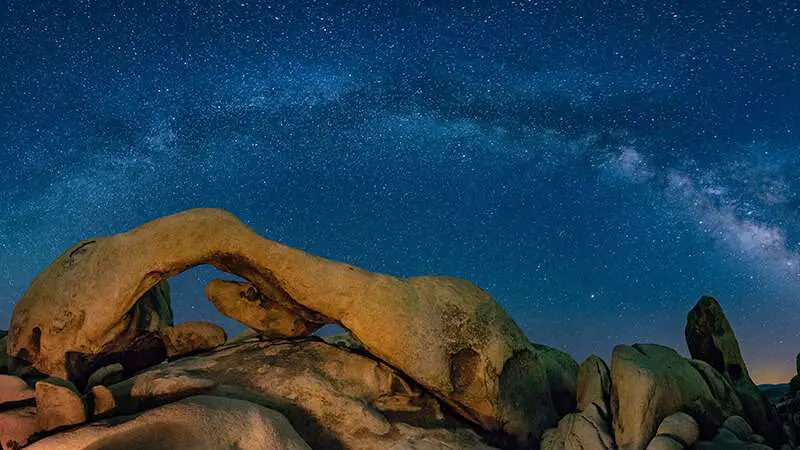
When viewing the Milky Way, you’ll first notice a hazy, milky glow stretching across the sky. This apparent haze is the countless number of stars in our galaxy.
As you look closer, you’ll also see some darker patches, known as dust lanes, blocking the light from distant stars. Notable constellations in the Milky Way include Sagittarius, Cygnus, and Cassiopeia.
Colors and Brightness
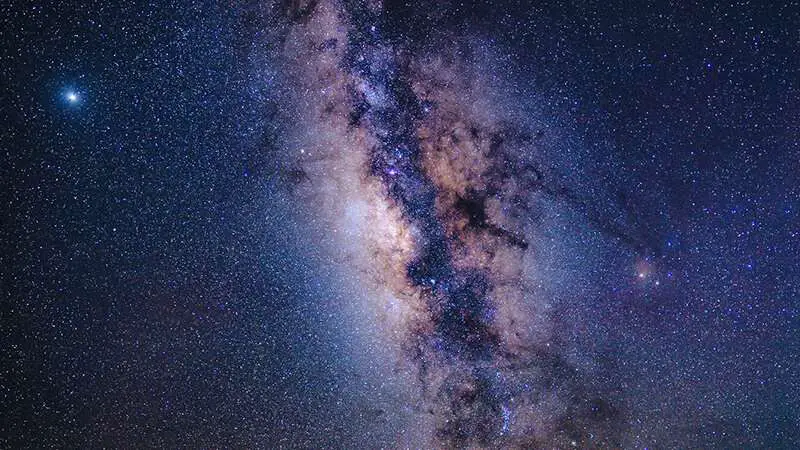
You’ll mainly see shades of white and gray with the naked eye, but when you use binoculars or a telescope, you’ll notice more stars and even subtle colors.
Depending on their temperature, stars can appear in various hues, such as red, yellow, or blue. The brightness of the Milky Way may vary depending on factors like light pollution and the time of the year you’re observing.
Capture the Milky Way in Photographs
As a stargazer, consider capturing the beauty of the Milky Way in photographs. I’ve provided beginner-recommended equipment and essential techniques for successful Milky Way photography.
Here’s an early photo of me trying to capture the Milky Way in a fairly high light polluted area.

Recommended Equipment
To capture a stunning Milky Way image, you’ll need the following equipment:
- A camera with manual controls, such as a DSLR or mirrorless camera
- A wide-angle lens with a large aperture, ideally f/2.8 or faster
- A sturdy tripod to keep your camera steady during long exposures
- An optional remote shutter release or intervalometer for added stability and convenience
Essential Photography Techniques for Beginners
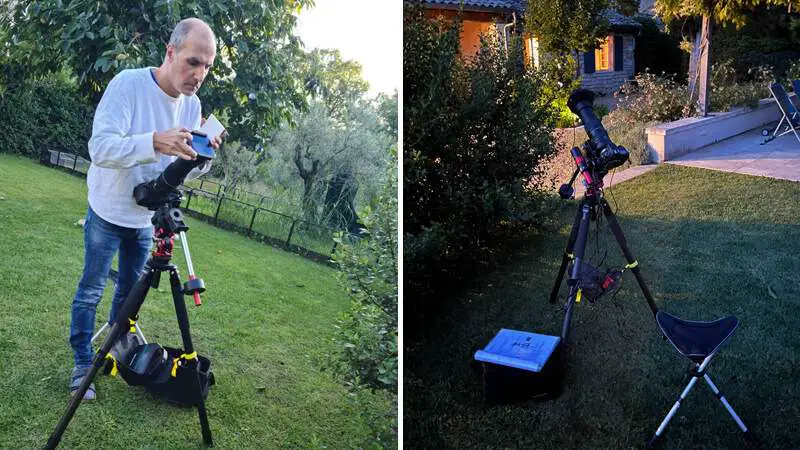
Here are some essential tips for photographing the Milky Way:
- Focus: Manually focus on a star or distant light, ensuring the smallest possible appearance in your image.
- Aperture: Use an aperture of f/2.8 or the smallest setting of your lens.
- ISO: Set your ISO between 3200 and 6400 for a suitable balance between sensitivity and noise.
- Shutter speed: Adjust your shutter speed between 10 and 25 seconds, allowing enough light to gather without causing star trails.
- White balance: Set your white balance to 4000K for a natural color representation of the night sky. If you shoot in RAW mode, you can adjust the white balance during post-processing.
Remember to check your results on your camera’s LCD screen and make any necessary adjustments as you go. Practice and patience will help you master Milky Way photography.
The Milky Way’s Significance in History and Culture
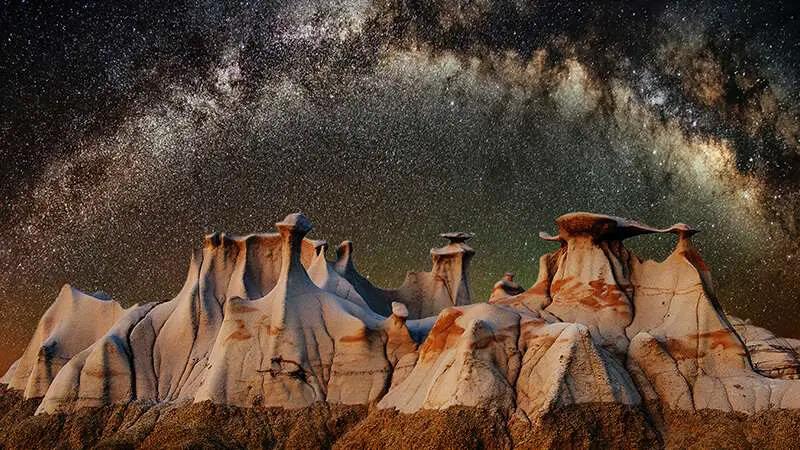
The Milky Way has fascinated people throughout history, with each culture interpreting it according to its beliefs.
For example, the ancient Armenians believed it to be straw strewn across the sky.
In Greek mythology, the galaxy’s name originates from the goddess Hera, who sprayed milk across the sky.
The ancients also knew about its existence, and its appearance has been recorded in various folklore and legends. Today, with the help of modern technology, we know it’s our home galaxy.
You can indeed see the Milky Way with your eyes in clear and dark skies.
Different names and stories exist for the Milky Way in other parts of the world. Knowing its significance in our history and culture helps us appreciate the wonders of the night sky even more.
So, next time you gaze at the stars, remember the endless tales and beliefs that the Milky Way has inspired over the centuries.
Frequently Asked Questions
Can you see the milky way from earth?
Yes, you can see the Milky Way from Earth. The Milky Way is the spiral galaxy that our solar system is a part of, and it spans across our night sky as a band of faint, hazy light. To observe it best, find a location far from city lights on a clear, moonless night, and let your eyes adapt to the darkness. You’ll be treated to a breathtaking view of our own galaxy, the Milky Way, stretching across the heavens.
Can we see milky way with naked eyes?
Yes, you can indeed see the Milky Way with the naked eye. On a clear, dark night away from light pollution, the Milky Way appears as a faint, hazy band of light stretching across the night sky. It’s an awe-inspiring sight and a testament to the natural beauty of the cosmos.
What does the milky way look like to the human eye?
The Milky Way, when observed with the naked eye, presents itself as a faint and diffuse band of light stretching across the night sky. It appears as if a milky, luminous river has been painted across the celestial canvas. The overall impression is a delicate, ethereal glow composed of countless distant stars, with subtle variations in brightness and density.
Is the Milky Way visible every night?
Yes, the Milky Way is visible every night, but it may not always be visible to the naked eye. The visibility of the Milky Way depends on several factors, including light pollution, weather conditions, and your location. If you want to see the Milky Way, find a dark place away from city lights.
Why can’t I see the Milky Way?
You may not be able to see the Milky Way for several reasons. One of the main reasons is light pollution, which can make the night sky too bright to see the faint light of the Milky Way. Weather conditions and your location on Earth can also affect visibility. Go to a site with little light pollution and clear skies to see the Milky Way with your naked eye, like Joshua Tree National Park in California.
What is the Milky Way?
The Milky Way is a spiral galaxy that contains our solar system. It is estimated to be about 100,000 light-years in diameter and contains billions of stars, including our Sun. The Milky Way is named after its milky appearance in the night sky, caused by the light of billions of stars. The Milky Way is just one of many galaxies in the Universe.
how can we see the milky way if we are in it?
While we are indeed situated within the Milky Way galaxy, when we refer to “seeing the Milky Way,” we are essentially observing our galaxy from the inside, looking towards its distant edge, where the concentration of stars and interstellar dust creates the breathtaking band of light that we perceive as the Milky Way in the night sky.
why do i see stars?
You see stars because the Earth’s atmosphere allows light from distant stars to reach your eyes. These stars are essentially distant suns emitting light in all directions, and when their light passes through the Earth’s atmosphere, it refracts and scatters, making them visible as points of light in the night sky. The twinkling or shimmering effect you sometimes observe is caused by turbulence in the atmosphere, which causes the starlight to momentarily change direction and intensity as it reaches your eyes.
Summary: Milky Way Naked Eye
Thank you for reading my article “Can I see the Milky Way with my eyes?”
So, is it possible to see the Milky Way with your eyes? Yes, you can see the Milky Way with your eyes! However, it may take some effort and planning to find the best conditions for viewing. If you’re an amateur astronomer like me, here are some tips to help you see the Milky Way.
But, how can we see the Milky Way with our eyes? First, find a dark location away from city lights. Look for a spot with little to no light pollution, such as a remote park or wilderness area. A Dark Sky Location will significantly improve your chances of seeing the Milky Way.
Next, check the weather conditions. Clouds and haze can obscure the Milky Way, so choose a night with good visibility. You’ll want a clear, moonless night for the best viewing.
Once you’ve found a dark location on a clear night, give your eyes time to adjust. It can take up to 30 minutes for your eyes to fully adapt to the low light conditions. Avoid looking at bright lights or using your phone during this time, or you’ll ruin your night vision.
When your eyes have adjusted, look for a faint light stretching across the sky. This band of light is the Milky Way! It may appear as a hazy cloud or a series of individual stars and dust.
The Milky Way is a beautiful sight and a reminder of the vastness and wonder of our Universe. Take your time to enjoy the view! Consider bringing a blanket and lying down to take in the view entirely.
With a little effort and planning, you can see the Milky Way with your own eyes. Finding a dark location away from city light, checking the weather conditions, and giving your eyes time to adjust are vital to seeing this beautiful sight.
So grab a friend, pack a picnic, and enjoy the wonders of the night sky!
Read my other articles in my Milky Way series:
- Can You See the Milky Way with a Half Moon?
- How Many Solar Systems in the Milky Way?
- When is Milky Way Season?
- Why Does the Milky Way Look Cloudy?
- Are all the stars we see in the Milky Way?
- Does the Milky Way orbit anything?
- Are the constellations in the Milky Way?
- How are Milky Way pictures taken?
- Can you see the Milky Way with a full moon?
- Can you see the Milky Way on a cruise?




